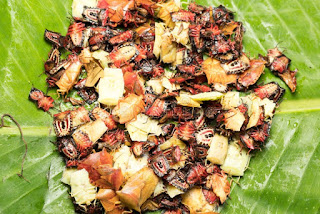Introduction:
In recent years, there has been a growing interest in entomophagy, the practice of consuming insects, due to its potential health and environmental benefits.
One such insect that has gained attention for its nutritional value and culinary potential is Tessaratoma papillosa, commonly known as the stink bug or shield bug.
 |
| Stinky Bug. |
While the idea of eating insects may be met with hesitation by some, the benefits of incorporating Tessaratoma papillosa into one's diet are worth considering.
First and foremost, Tessaratoma papillosa is rich in protein, making it an excellent source of this essential nutrient. In fact, studies have shown that stink bugs contain comparable levels of protein to traditional animal sources such as beef or chicken.
This high protein content makes
Tessaratoma papillosa a valuable addition to diets, particularly for
individuals looking to increase their protein intake without relying solely on
meat.
Furthermore, Tessaratoma papillosa is an environmentally
sustainable food source compared to traditional livestock. Insects require
significantly less land, water, and feed to produce the same amount of protein
as cattle or poultry. Additionally, they produce fewer greenhouse gas emissions
and generate less waste, making them a more environmentally friendly option for
feeding a growing global population.
From a culinary perspective, Tessaratoma papillosa offers
versatility and unique flavor profiles that can enhance a wide range of dishes.
Whether roasted, fried, or ground into flour, stink bugs can add a delicious
nutty or earthy taste to both sweet and savory recipes. In many cultures around
the world, insects are celebrated as delicacies and are incorporated into
traditional cuisines in various creative ways.
Despite the numerous benefits of consuming Tessaratoma
papillosa, it is essential to source insects from reputable sources to ensure
safety and quality. Additionally, individuals with allergies to shellfish or
crustaceans should exercise caution when consuming stink bugs, as they belong
to the same arthropod family and may trigger allergic reactions in sensitive
individuals.
Conclusion:
In conclusion, the consumption of Tessaratoma papillosa offers a multitude of benefits, including high protein content, nutritional richness, environmental sustainability, and culinary versatility. While the idea of eating insects may be unconventional to some, embracing entomophagy and incorporating stink bugs into one's diet can contribute to improved health and well-being for both individuals and the planet
Why should we consider eating insects (entomophagy)?
Entomophagy offers a sustainable protein source that requires fewer resources such as land, water, and feed compared to traditional livestock. Insects are highly nutritious, rich in protein, healthy fats, vitamins, and minerals. Embracing entomophagy can help address food security and environmental challenges.
Are all insects safe and suitable for consumption?
Not all insects are safe for consumption, as some may carry toxins or pathogens harmful to humans. However, many edible insect species have been identified and consumed safely for centuries across various cultures. It's crucial to source insects from reputable suppliers and ensure they are raised and prepared in hygienic conditions to mitigate any health risks.
How can insects be incorporated into our diets?
Insects can be incorporated into diets in various ways, including as whole insects, ground into flour for baking, or processed into products like protein bars and snacks. They can also be cooked and seasoned to suit different culinary preferences. As awareness of entomophagy grows, innovative recipes and products are emerging, making it easier for individuals to incorporate insects into their diets seamlessly.




